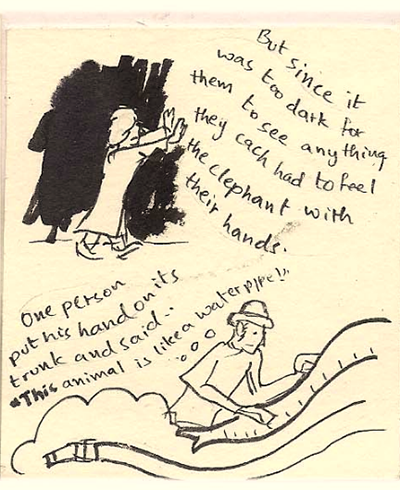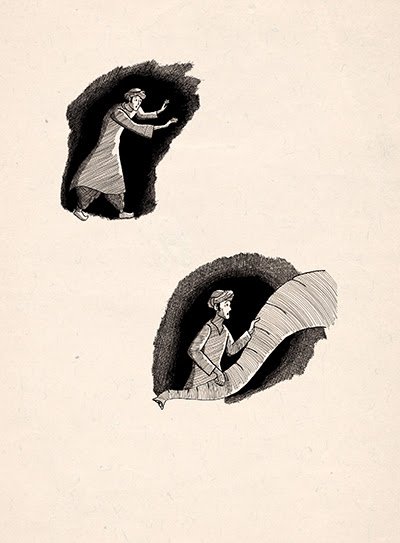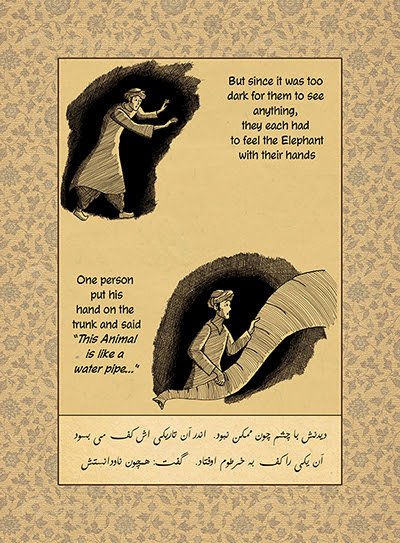Get Behind the Scenes and View the Final Pages of Sufi Comics Rumi!
It's an exciting time in our journey of Sufi Comics Rumi. It's time to reveal some sneak previews of the final pages, and get some exclusive insights from the members of the Sufi Comics team. This month we go behind the scenes on the production of the pages...So who works on the production of the pages? Well, brother Mohammed Ali Vakil creates the template design of the page and selects the colors of the comics, then brother Abdul Gafur prepares all the pages based on the template designs and colors of the comics. Thereafter, brother Rahil will do the cover and back page of the book. The pages are created with Photoshop and also Corel Draw for the lettering of the text.I had a chat with brother Ali about the process of production, why this style was selected, and any challenges or changes that may have gone into the process. From this, I learnt a lot about what goes into the process of production, and even learnt some interesting ideas about comics from different regions acquiring their own unique style!So what inspired the style of Sufi Comics Rumi? How will the final pages look? Read on as we reveal sneak preview of the pages and more!
What is the process of production? How do you develop from each stage and are there any challenges involved?
"After the thumbnails, pencils & Inks, Rahil sends us the final Inks of the pages via Dropbox.
 Gafur then takes the template & prepares the page with the Inked Comic, English Lettering, and Farsi Text...
Gafur then takes the template & prepares the page with the Inked Comic, English Lettering, and Farsi Text...

Once I select the colors, he completes the page by coloring the comic:

How and why did you select this style for Sufi Comics Rumi?
"The message of a comic to the reader is not only in the words, but also in the art style. We wanted to be careful what style we use.Comics from every region have developed their unique style based on their culture & the theme of the story they’re telling. For example you’ll see in American comics the art focuses a lot on exaggerating the muscular part of the anatomy to emphasize on the outer material physical power.Japanese Manga Comics style pay a lot of importance to the back ground environment & what is happening from moment to moment, giving the reader a sense of presence. It is their Zen culture that have influenced their style.
"The message of a comic to the reader is not only in the words, but also in the art style. Comics from every region have developed their unique style based on their culture & the theme..."
Indian comics like the ones from Amar Chitra Katha have inherited the style from traditional Indian paintings. The poems of Rumi were written in farsi the 13th century. Sine we were going to narrate the poems with illustrations, we adopted an art style similar to the kind illustrations done by artists during the 13th Century.We referenced Miniature paintings, Floral & Geometric patterns and Arabic & Persian Calligraphy and presented the comic with all these elements.The idea was to give reader the feel of the space during which the poems & stories took place."
Were there any changes/challenges involved in the overall process?
Are you pleased with the overall look of the pages including border patterns, positioning of text? If you had to do it again would you do anything differently in the process?
"The page style is almost the same as our second book "The Wise Fool of Baghdad". Our initial aim was to give it a different look, but nothing was coming out as good.While speaking to Muqtar bhai about the project, he advised us that there's nothing wrong in repeating what is already beautiful. (Good Advice!) With that we decided to use the same style as we did with The Wise Fool of Baghdad. I think moving forward this page style might become our signature look!" Stay tuned for our next post as we go Behind the Scenes on the calligraphy of the book!

